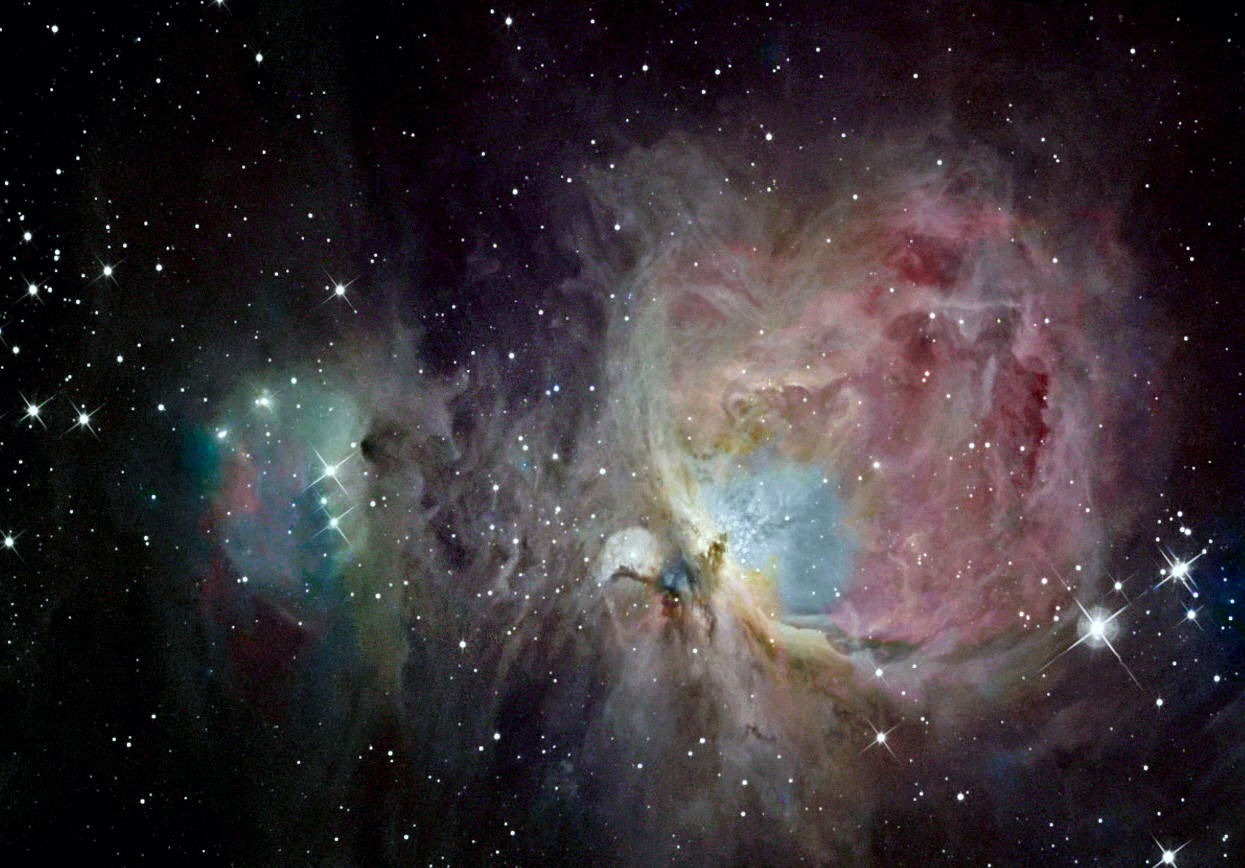
Messier 42 The Great Orion Nebula
Please Page Down to View More Images and Information

This image was processed in December 2005 from data sets that were taken in 2004 at Kitt Peak National Observatory. Total exposure time for this image was Luminance / Hydrogen Alpha 2.4 Hours, Red / Hydrogen Alpha 38 Minutes, Green & Blue 35 Minutes for each color. Two hundred and seventy five individual data frames were taken for this image.
The Luminance and Hydrogen Alpha data were blended & the Red and Hydrogen Alpha data were blended using Photoshop CS2.
The combined Luminance / Hydrogen Alpha image was processed with MaxIm DL Digital Development and then two iterations of Lucy-Richardson Deconvolution was applied. Image processing was completed with MaxIm DL and Adobe Photoshop CS2.

This image is the combined data with the color removed and further processed to show the extensive nebulosity of M42.


The left image was the original image on this page and was processed with only part of the data collected. As you can see by comparing with the image on the right that uses all of the data collected, the more data collected the better the image detail.
Image Credit: Fred Calvert / NOAO / AURA / KPNO / NSF
Taken December 14, 2004 @ Kitt Peak National Observatory
Information about this image:
The Constellation Orion and the Orion Nebula are one of the most recognizable constellation and nebula's in the Northern skis. Just step out doors on any crisp winter morning and if you live in an area that even resembles dark, the nebula can be see naked eye as a grey patch just below Orion's belt.
The past decades of research on the Orion Nebula have revealed that the visible nebula, M42, the blister of hot, photo-ionized, luminous gas around hot Trapezium stars, is only a thin layer lying on the surface of a much larger cloud of denser matter, the Orion Molecular Cloud 1 (OMC 1). It was the first deepsky observation by William Herschel with a self-constructed reflecting telescope of 6-foot focal length in 1774. In 1789, with some prophetic touch, he described his observations with his 48-inch aperture, 40-foot FL scope as "an unformed fiery mist, the chaotic material of future suns." In 1880, M42 was the first nebula to be successfully photographed, by Henry Draper. (SEDS)
A must read is a book written by Professional Astronomer C. Robert O'Dell titled "The Orion Nebula" ISBN 0-674-01183-X published in 2003. The book is a history lesson on the Orion Nebula and uses of the Hubble Space Telescope by O'Dell to unlock it's secrets. It is a must read for anyone that is fascinated by this nebula. And who couldn't be?
The image below taken with a Nikon F3 and 135mm lens from Cold Spring Observatory and shows the constellation Orion. The Orion Nebula (M42) pictured above is located at the six o'clock position below Orion's belt.
The third image was processed to show what is known as the Running Man in the nebula. As you can see when processed to show the interior of the bubble, it appears more like the star child in 2001 a Space Odyssey.
To see an animated tour of the center of the Orion Nebula click here.
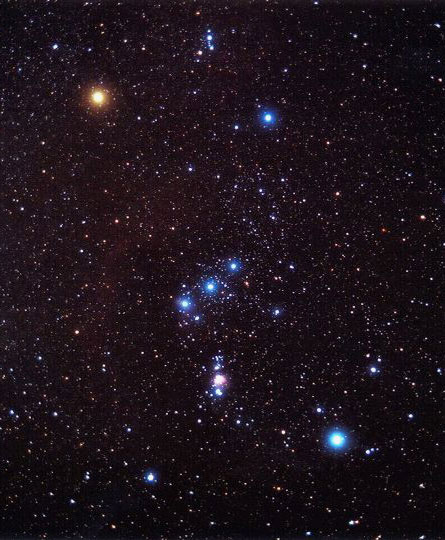


Equipment:
Televue 76 with Televue Field Flattener piggybacked on a 20" RC Optics Telescope and Paramount ME Mount, SBIG ST10XME / CFW8 Color Filter Wheel
Exposure: LRGB + Ha
Luminous / Hydrogen Alpha = 2.4 Hours, Red / Hydrogen Alpha = 38 minutes, Green = 35 minutes, Blue = 35 minutes
Why so long to process this image?
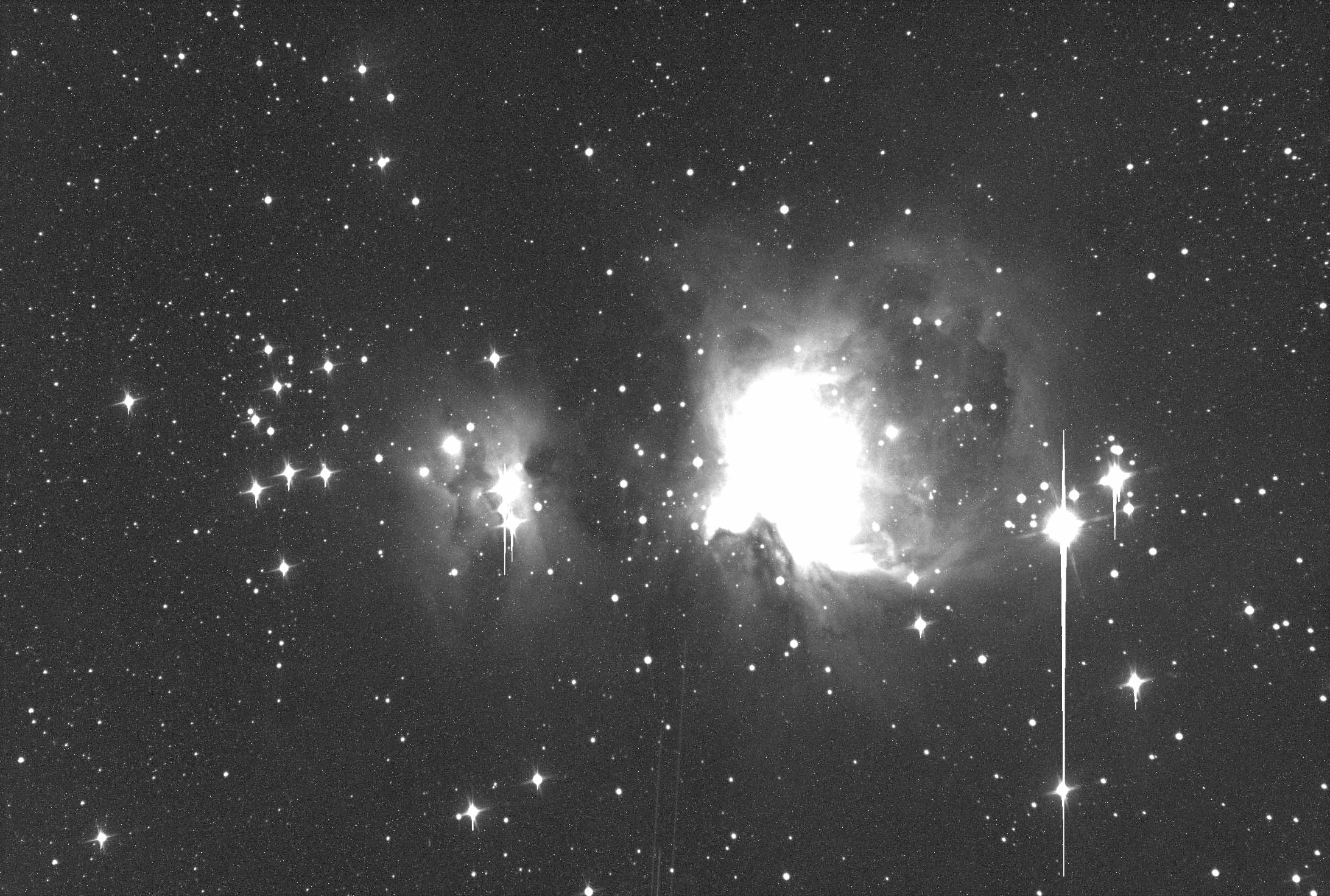
This is a single unprocessed 40 second blue data frame of the image at the top of this page. In astronomical imaging, the data frames are captured in a FITS format and must be calibrated using: 1. Dark Frames, 2. Flat Field Frames and 3. Bias Frames. Dark frames remove the noise of the CCD chip that is present due to thermal and electrical properties commonly called "noise" The Flat Field frame is used to remove defects in the optical path of the telescope, such as dust on the optics. Bias frames are used to remove the electrical noise from the CCD read-out (When the data is read from the CCD chip to the computer) and other extraneous electrical noise in the camera system. Other defects that must be removed are blooms that occur when the CCD chip pixel capacity is exceeded, which are the long white vertical lines in the frame. To correct a single frame can take anywhere from minutes to hours. In the case of this image, each frame required about 20 to 30 minutes of work. Multiply this by two hundred and seventy five data frames and the many hours required to correct other funnies in the image, over a hundred hours of post processing was required to get to the image at the top of the page. Each FITS Data frame is 6.13 megabits in size for a total of 1.69 Gigabits of collected data.
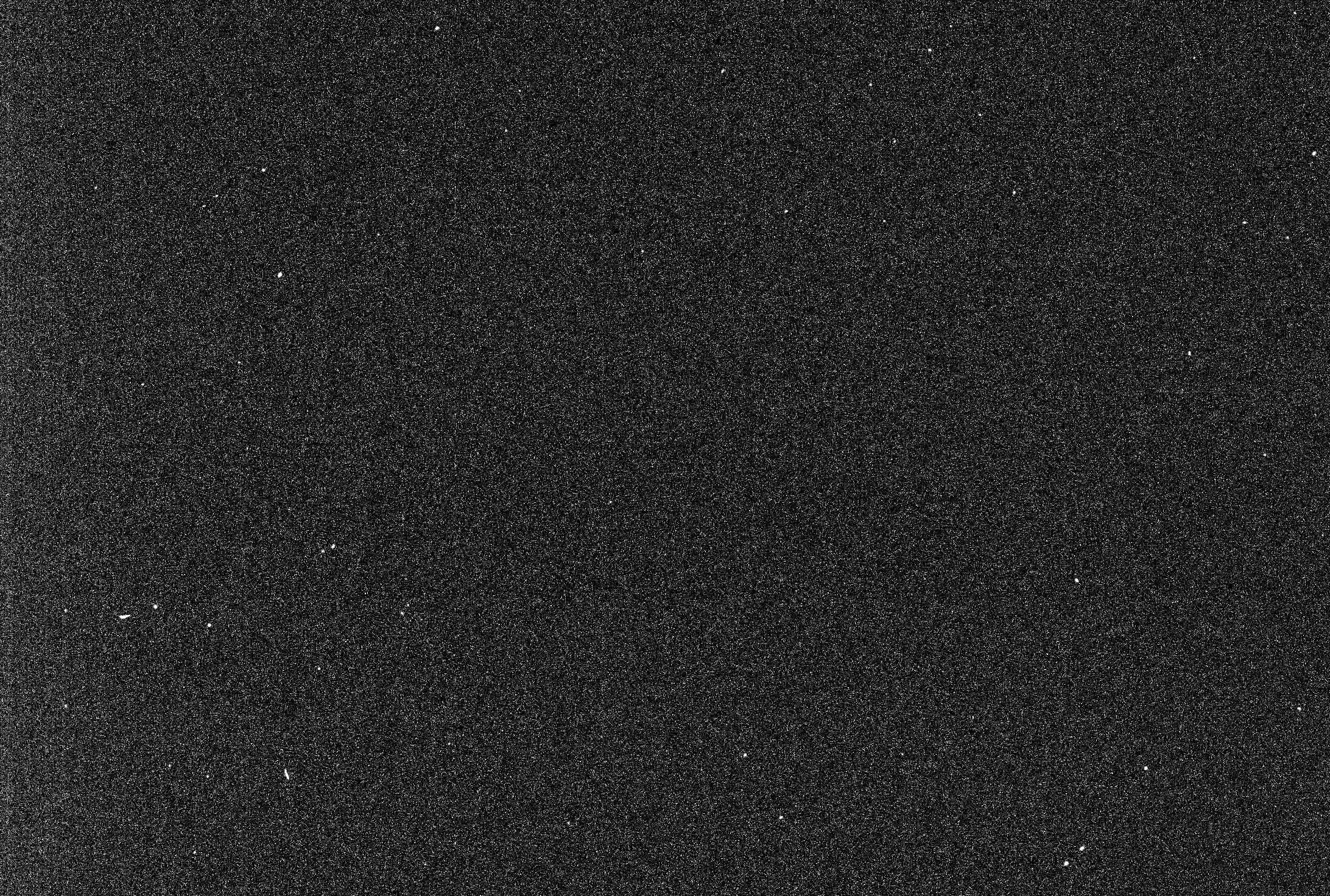


Dark Calibration Frame Flat Field Calibration Frame Bias Calibration Frame
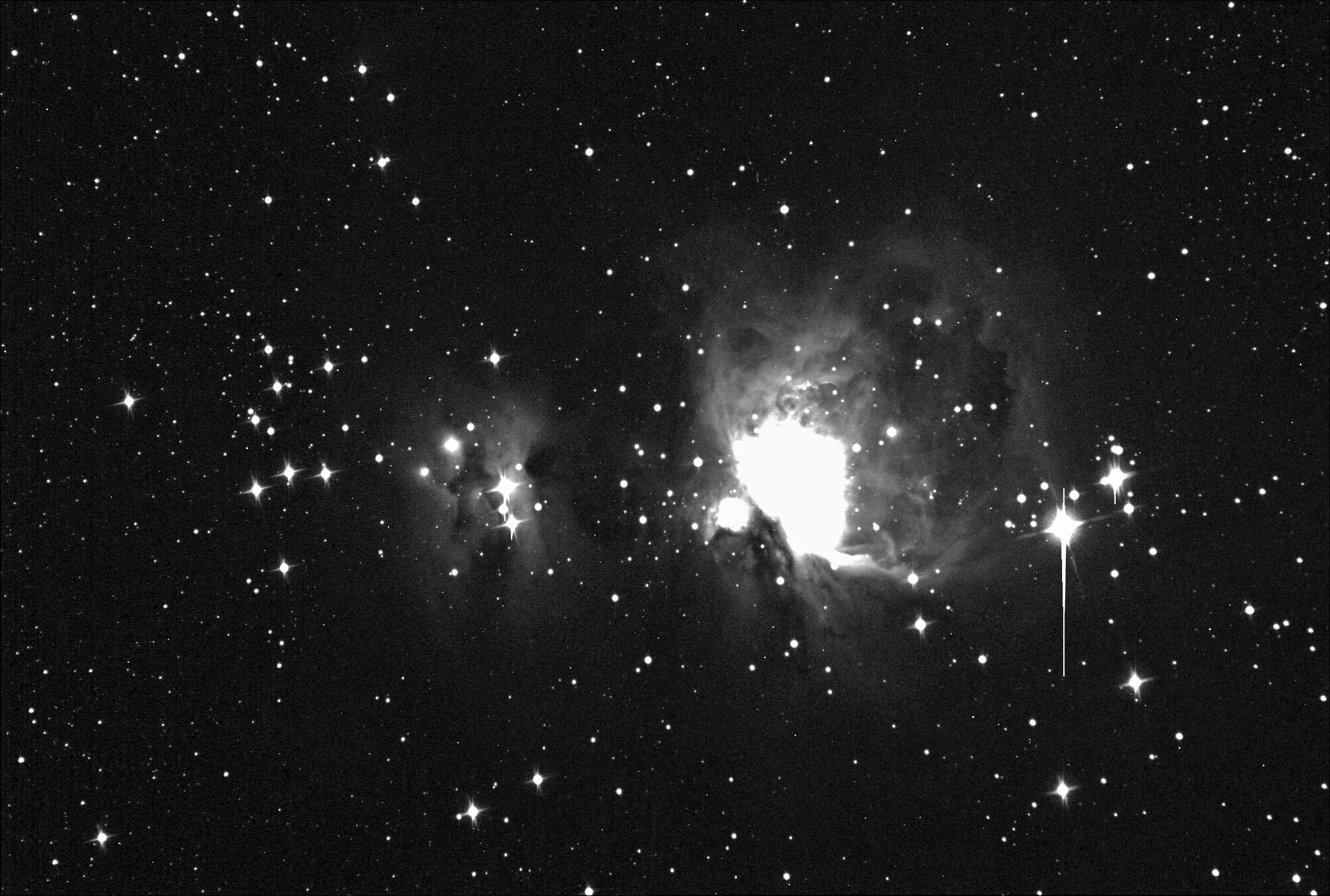
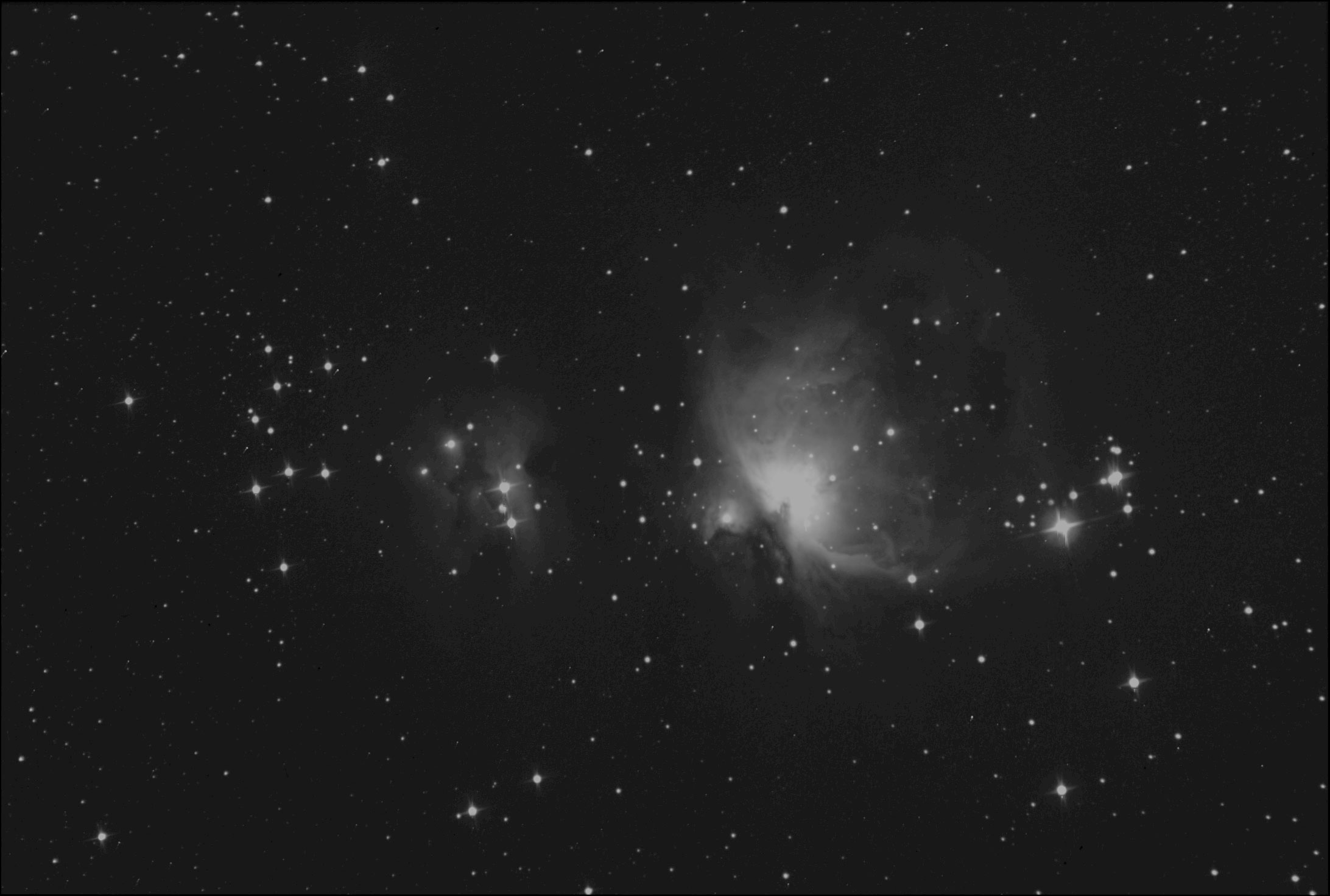
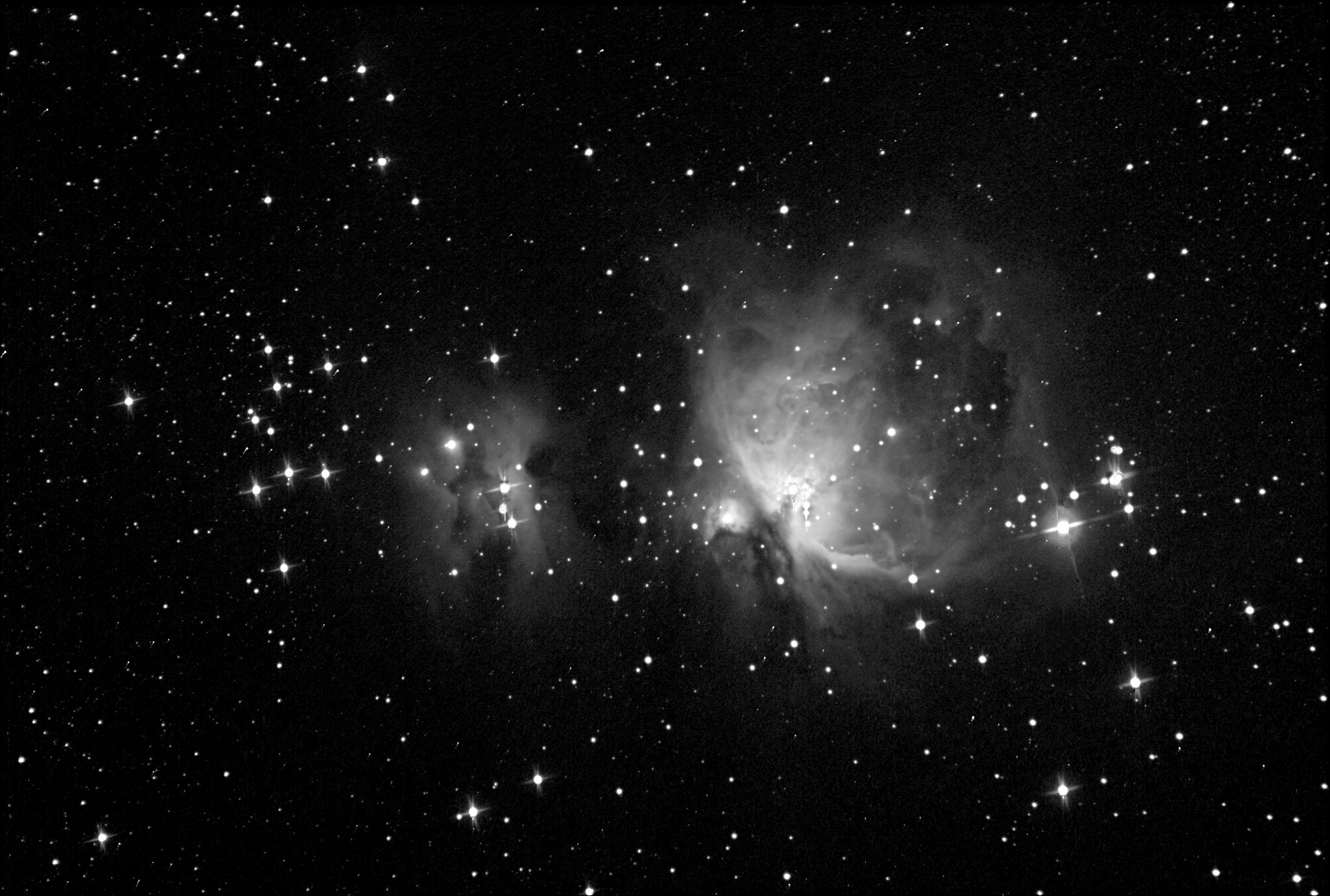
Single Data Frame after dark/flat/bias subtracted Single Data Frame after de-blooming and stretching Combination of 68 Calibrated Blue Data Frames
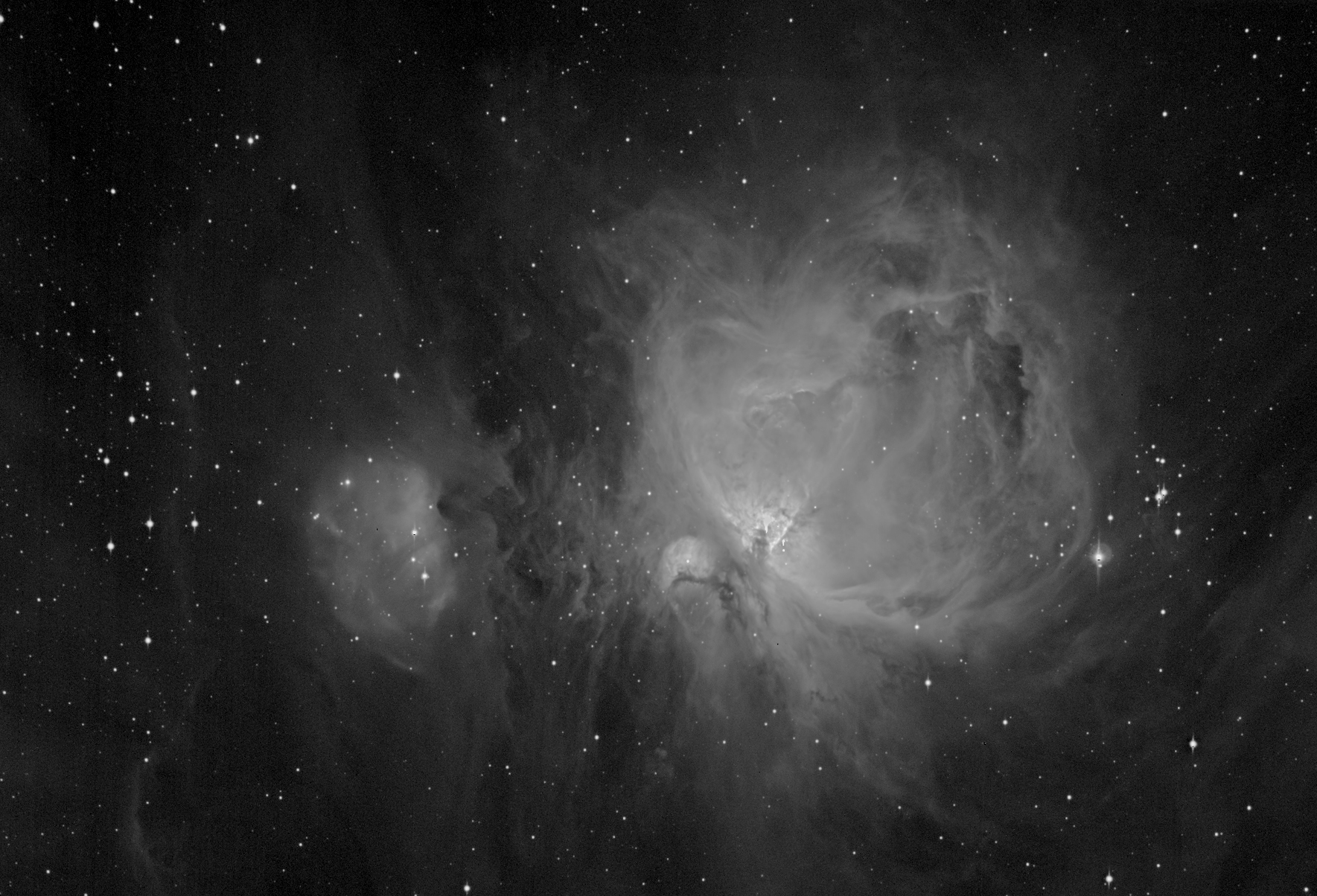
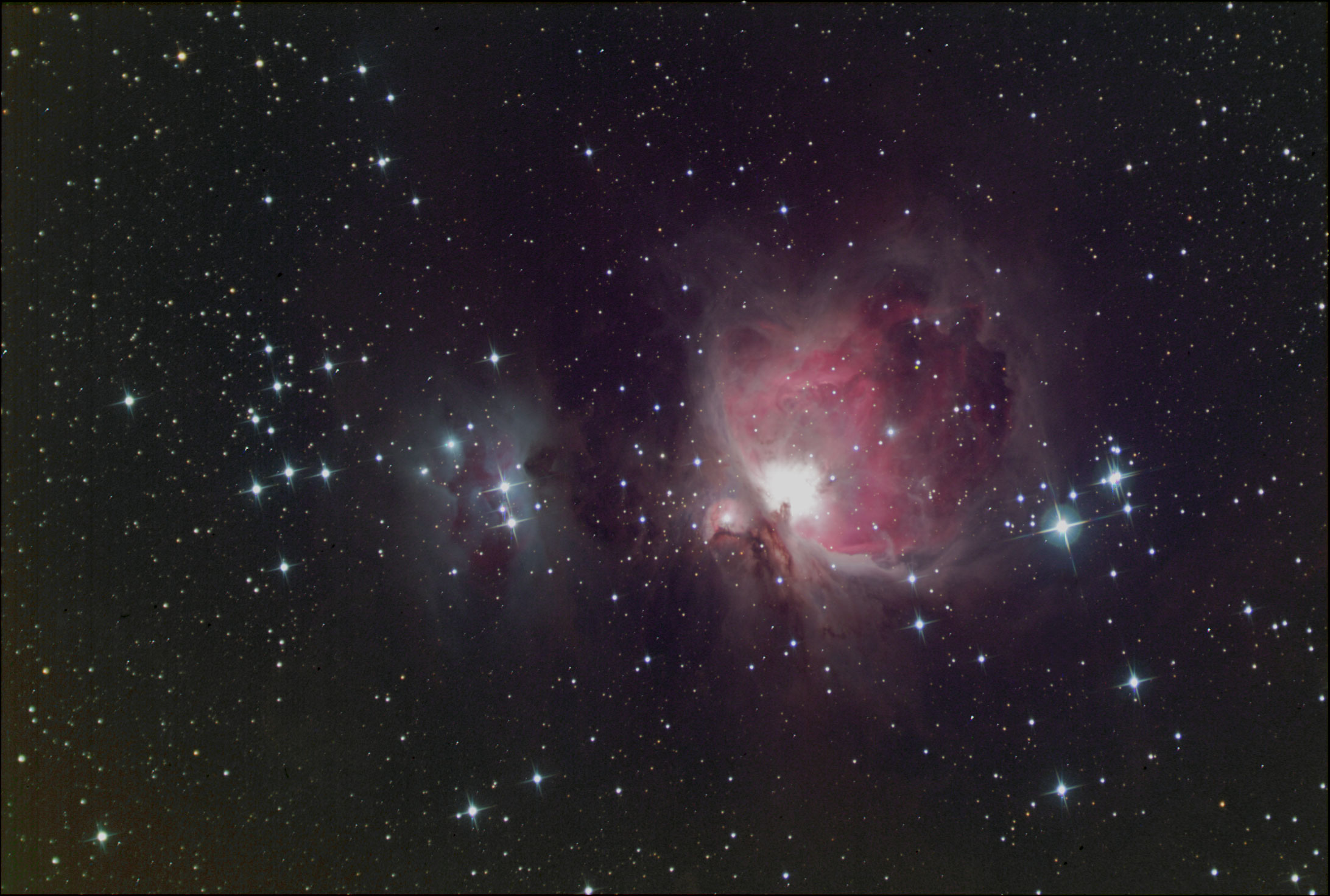

Luminance and Ha Data (71 Data Frames) Ha/Red, Green, Blue Data (204 Data Frames) Final Processed Image (275 Data Frames)
Seeing in a Different Light - Narrow Band Image of M42 taken by Eric Africa
Please page down for information about this image
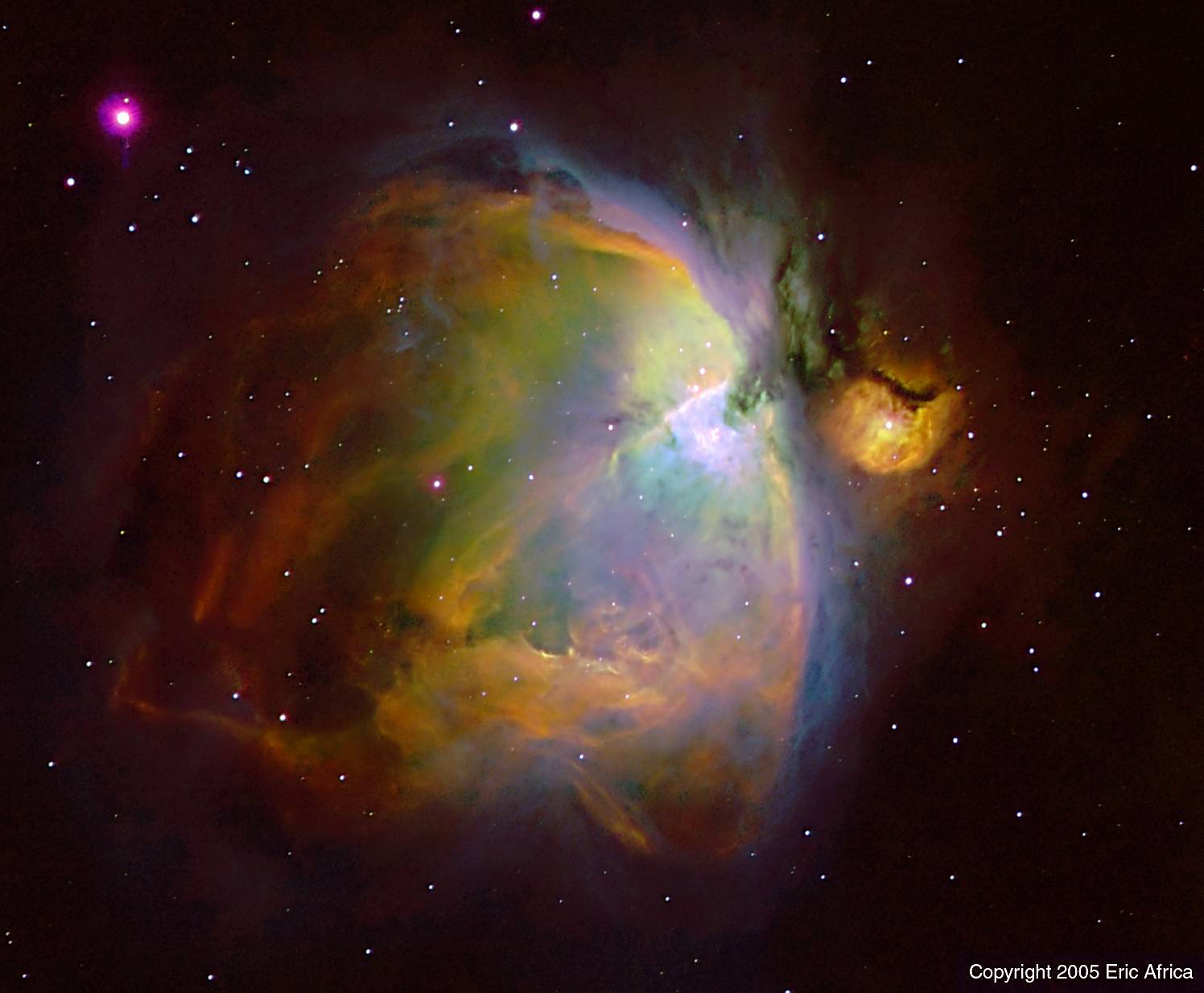
There is a technique in astronomical imaging called narrow-band-imaging. This is where filters are placed in front of the imaging camera’s chip to preferentially send data for only certain wavelengths of light through for the chip to record what will ultimately be the final image. This technique is actually what I have been applying in a way with all the color images I’ve been sharing – the camera I am using uses a black and white chip; by placing color filters for Red, Green and Blue in front of the chip, I gather data that will ultimately yield the color images I’ve come up with to date.
With narrow-band imaging, the filters used transmit light of certain scientifically-interesting wavelengths – these would be wavelengths of light transmitted by atoms of elements excited by radiation from nearby sources (usually a star). The Hubble Space Telescope, for instance, uses (among others) filters that transmit the light from ionized sulfur, hydrogen and oxygen. Amateur imagers have access to similar type filters, and have been using such filters to create spectacular false-color images of nebulae. One advantage that this type of imaging has is that it is less dependent on the presence (or absence) of light pollution or the Moon. Bottom line, if the night is clear, a narrow-band imager can image. “Regular” (color) imagers are a little more constrained by such sources (it’s not impossible, just much harder to get a great image with the Moon or light pollution present).
This is essentially a false-color image. As hinted earlier, I shot this through filters tuned to transmit the wavelengths emitted by ionized Sulfur (S-II), Hydrogen (H-alpha) and Oxygen (O-III). I listed the filters In order of increasing wavelength of light transmitted (S-II, H-alpha, then O-III). In the RGB sequence, the S-II data is used to represent the color Red, H-alpha the green, and O-III the blue.
I need to emphasize a point: to the human eye, the S-II color is actually a deep red, H-alpha a deep (but somewhat lighter) shade of red, and O-III a blue-green color (teal, technically). Therefore, these color narrow-band imagers do *not* represent colors we will actually see if we could see these objects and their colors. However, they do show details of the objects that shine in the wavelengths as described above.
The skies of December through around February showcase some of the most spectacular objects visible in the sky. Among them is this nebula, the Great Nebula of Orion. Also designated as M42, this is the 42nd object cataloged by the French comet hunter Charles Messier. His list is actually a list of objects to *not* look at, as his primary interest was comets. He compiled this list of comet-like objects as a favor to other comet hunters so that when they see these objects, they will know that they are not discovering new comets, but rather looking at “nuisance objects”. It turns out that this list is a list of among the best deep-sky objects out there in the universe.
As hinted by its name, M42 lies in the constellation Orion. This is one of the most recognizable constellations in the sky, visible to the south (at least to Northern Hemisphere dwellers) with its three belt stars all lined up in a (almost) neat row. M42 lies just “below” this belt, and is referred to as Orion’s sword. If you look closely at this “sword”, you might notice that the star in the sword is a bit fuzzy. Guess what? That’s the nebula! (Text by Eric Africa)
Back to December 2004 Run Home